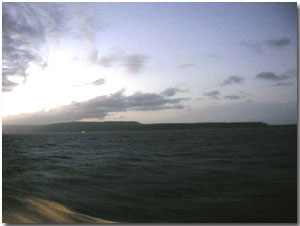Ile de la Tortue
The Caribbean Turtle Island
View Larger Map The blue mark shows where the island is.
In 1493 Columbus sailed by an island shaped like a turtle and called it La Tortuga, the first Caribbean Turtle Island. In its history, it passed back and forth between the Spanish and French. Sometimes even the Dutch and English got involved.

Now it is called Ile de la Tortue, which also means Turtle Island.
I got to see the island in the Caribbean twilight from a cruise ship. I told my human to take a picture. It was getting dark quickly like it does near the equator, so we had to fix the picture when we got home so you could really see the turtle shape.
I couldn't go onto the Caribbean turtle island, but we spent a day on a beach in Haiti, so I know something of what it looks like. The water is a beautiful aqua blue and the trees grow tall even on the rocky soil.
From the 1600s, Turtle Island was a pirate island. A group of pirates, called
Brethren of the Coast, made it their center.
They needed the wood for ships. And they could hunt the wild boars for food.
Later people put plantations on the island and tried to use slaves, but the slaves didn't like that and would not obey very well, so that didn't last long.
Now Ile de la Tortue is part of Haiti. No one knows exactly how many people live there. Some say 28,000, and some say 60,000. Haiti is a very poor country with lots of troubles, so this island does not have all the things North Americans are used to. The people often make their own services because the government doesn't.
If you want to go to Ile de la Tortue, you will probably leave on a barge from Port de Paix.
I think that this Caribbean Turtle Island is like other turtles and tortoises -- beautiful, full of secrets, and in danger.
Learn about another
Turtle Island in Greece
Read more
turtle, tortoise, and terrapin facts.
Keep it slow and steady.
Enjoy this page? Please pay it forward. Here's how...
Would you prefer to share this page with others by linking to it?
- Click on the HTML link code below.
- Copy and paste it, adding a note of your own, into your blog, a Web page, forums, a blog comment,
your Facebook account, or anywhere that someone would find this page valuable.